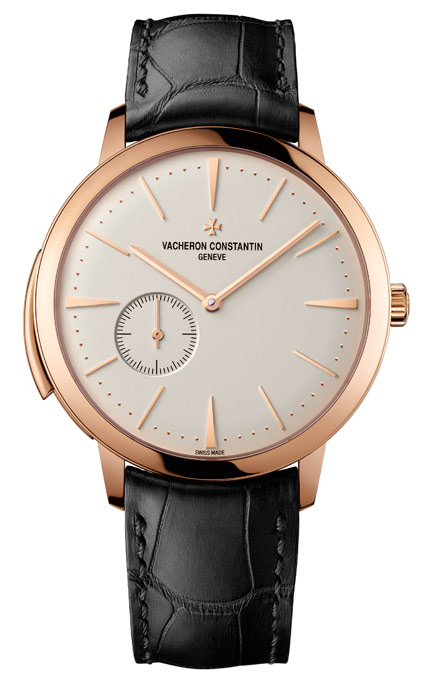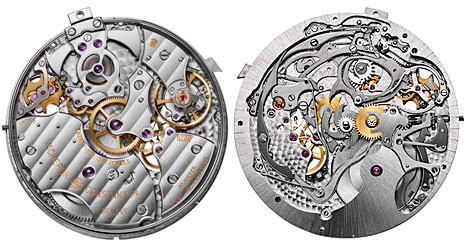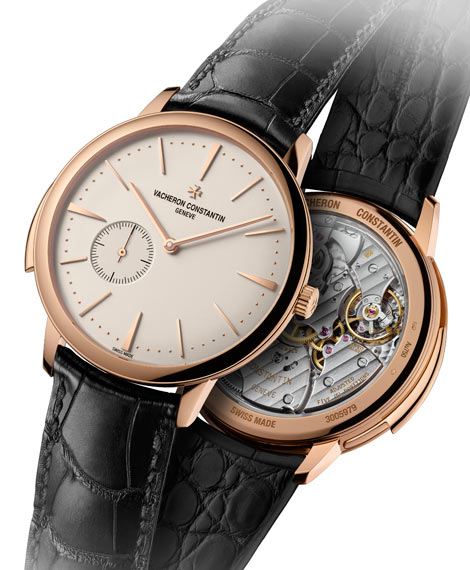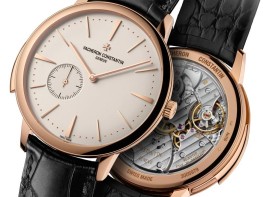This timepiece realizes the challenge of the thinnest minute repeater calibre and the thinnest minute repeater watch on the market.
Few watchmakers truly master the art of striking mechanisms, the horological complications acknowledged to be the hardest of all to produce. Vacheron Constantin has been creating such miniature pieces for over two centuries, and is now presenting the Patrimony Contemporaine Ultra-Thin Calibre 1731, bearing the prestigious Hallmark of Geneva. It is the thinnest minute repeater calibre and the thinnest minute repeater watch on the market with just 3.90 and 8.09 mm thin respectively.
It was in the 18th century that the first minute repeater watch was devised to provide an audible indication of the time in the dark, in an era before the advent of electric lighting. Each miniature repeater watch is unique and bears the unique signature of the master craftsman who made it. On demand, the minute repeater sounds the hours, quarter-hours and minutes. After activating the repeater slide – in this case the only element of this major complication visible on the dial side – a hammer strikes the low-pitched gong to mark the hours, while the quarters are played by two hammers on the two gongs – one low-pitched and the other high-pitched – and the minutes are sounded on the high-pitched gong.
The Manufacture made its first minute repeater on a pocket-watch in 1810, before combining striking mechanisms with major complications throughout the following decades. Watches that have made history, such as the one developed for King Fouad of Egypt in 1929, or the timepiece created in 1935 for his son, King Farouk. In 1941, Vacheron Constantin launched its first wristwatch equipped with a single complication in the shape of a minute repeater housed within an ultra-thin movement: Calibre 4261. The quest for extreme slenderness continued over the years, and in 1992, the Manufacture presented Calibre 1755, a minute repeater measuring just 3.28 mm thick. Today, Vacheron Constantin celebrates this emotionally charged complication with an all-new calibre inspired by its illustrious predecessors: 1731, thus named in tribute to the birth of the brand founder, Jean-Marc Vacheron.

Calibre 1731
It was in 2009 that Vacheron Constantin decided to create a new minute repeater. Four years proved necessary to solve this complex equation. While the new Calibre 1731 is barely thicker than its predecessor from 1993 – 3.90 compared with 3.28 mm – due to its impressive 65-hour power reserve, it is nonetheless the thinnest on the market today.

Nor are the technical feats confined to the ultra-thin side of its nature, since Calibre 1731 is equipped with a highly ingenious device developed by Vacheron Constantin in 2007 for the 2755 movement: a flying strike governor. Contrary to classic lever-type governors, this one is completely silent. Its role is to steady the rate at which the hammers strike the gongs. Without a regulator or governor, this musical sequence would take place at the speed of the striking barrel-spring, and would merely produce a rush of indiscernible notes.
The device developed by Vacheron Constantin comprises two inertia-blocks or weights designed to act as a brake on the rotating shaft of the governor and thus evening out the energy supplied by the barrel spring. To achieve this, it makes use of two opposing centrifugal and centripetal forces. When the governor spins, the centrifugal force pivots one end of the weights outwards so that the other end presses on the shaft so as to stabilise the rotation speed and thus ensure a steady cadence. The governor bears Vacheron Constantin’s Maltese Cross emblem.
The quest for perfect harmony
Particular care was devoted to the acoustics of the Patrimony Contemporaine Ultra-Thin Calibre 1731. The gongs are not only connected to the case middle to as to amplify the sound, but also for the first time stacked rather than placed side by side. The case is made to be as one with the movement, within a clever composition incorporating such subtle parameters as the airflow between the mechanism and the case, designed to achieve optimal propagation of the sound. The case itself has been built without joints so that the elements can interact literally metal against metal and thus enhance the amplitude of the sound, while the flying governor ensures a steady rate of the hammer blows on the gongs.
Tests are performed at 4h49 precisely!
The true soul of a repeater watch, the individual chime of each watch is recorded and carefully stored before it leaves the Manufacture, thus constituting a “soundprint” duly registered in the Vacheron Constantin archives. This procedure guarantees not only the lifelong repair of all its timepieces, both historical and contemporary, but also the ability to restore within its workshops the unique sound of each model equipped with a minute repeater.

The work of a single master-watchmaker
For a master-watchmaker, taking part in creating striking watches is a supreme honour. Watchmakers capable of mastering striking mechanisms thus belong to an extremely elite circle. At Vacheron Constantin, only the master craftsmen working in the “Grandes Complication” workshop create such marvels. They must have acquired at least 15 years’ experience in the various other workshops, before working for two years under the mentorship of a master. The minute repeater is the most demanding complication due to the large number of tiny parts that must be patiently assembled and made to interact, before repeatedly setting and adjusting them to the point of achieving perfectly smooth running and an absolutely pure sound. A single watch takes from three to six months to assemble and adjust.
Finishes in keeping with the noblest Fine Watchmaking traditions
The components of Calibre 1731 are patiently finished one by one, even though some will remain hidden. Whereas the mainplate is circular-grained, the hammers are specular polished. The bridges are enlivened with a Côtes de Genève pattern. The seven bridges of Calibre 1731 are bevelled.
The design of the Patrimony Contemporaine Ultra-Thin Calibre 1731 is inspired by an ultra-thin model created in 1955 to mark the Vacheron Constantin bicentenary and then revived in 2004 to give life to the Patrimony Contemporaine, reference 81180. Since then, its extreme slenderness, its pebble shape, its curved bezel, its cambered dial and crystal, its beaded minute circle, along with its baton-shaped hands sweeping over alternating triangle and baton-shaped hour-markers, have firmly established it as a timeless classic.

While the new Patrimony Contemporaine Ultra-Thin Calibre 1731 has remained loyal to its timeless design codes, its case has been the object of subtle and complex workmanship so as to form a unified whole with Calibre 1731. The curve of the case middle has been accentuated so as to trim down the silhouette, while the sapphire crystal case-back has been opened as broadly as possible so as to reveal the hammers, along with a rare glimpse of the gongs. On the dial, the small seconds offset is positioned at 8 o’clock, a first in the Patrimony Contemporaine line.
Featured brand






